As the need for cybersecurity continues to grow, more methods of defending against cyberattacks are popping up. “Simulation” refers to the ability to mimic malicious actors’ techniques, procedures and tactics. Most attack simulation tools and platforms provide an automated or semi-automated means of achieving the attacker’s perspective of the victim’s network. Cyberattack simulation is the latest in the line of cyber defense.

The 10 best cyberattack simulation tools are listed below.
- Cymulate
- Randori
- Foreseeti
- BreachLock
- AttackIQ
- Infection Monkey
- CALDERA
- Picus
- NeSSi2
- XM Cyber
Table of Contents
1. Cymulate
Cymulate is a software-as-a-service platform that simulates cyberattacks and breaches. With the help of Cymulate, companies can identify gaps in any cybersecurity protocol/policy. The software is used to challenge a company’s security protocol, find the existing security gaps and assist the company in taking steps to close those gaps.
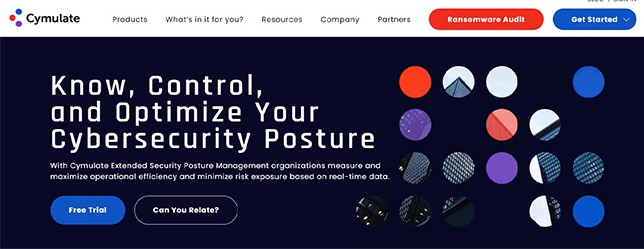
The main advantage of Cymulate is that the software carries out quick and accurate risk assessments to determine vulnerabilities, gaps and external exposure in the organization. However, a major disadvantage is that Cymulate’s advanced attack simulation program does not offer multi-platform support and is currently available only as cloud-based software.
Cymulate has solid security, such as a database that updates daily with the latest threat assessments and simulations to validate a company’s defense, while also letting the company know if the protection is adequate.
Cymulate’s “Immediate Threat” package costs $1,500 per month or $18,000 per year for companies with at least 250 endpoints. Additional features cost more. A 14-day free trial is also available so companies can try out the various features and pick what works best.
Cymulate is an Israeli cybersecurity company founded by a team of ex-intelligence officers from the Israel Defense Forces.
Overall, the software works by running simulated attacks on business networks. Whenever a vulnerability is identified, the system automatically sends guided instructions on how to fix/improve the exposure.
2. Randori
Randori is a simulation tool designed to help companies’ security teams understand the attacker’s perspective, a method known as red teaming. Randori is used to get an encompassing view of every internet-connected device/asset in a firm. Security and IT teams can then use that insight to reduce the risks associated with process failures, misconfigurations and blind spots. The teams can also use insights from Randori to gain control of the company’s attack surface.

The Randori Attack Platform records, analyses and delivers actionable intelligence from an attacker’s point of view and presents the investigation to the security or IT team. One advantage of Randori is that the platform runs continuously and automatically, enabling the software to locate new targets to exploit, discover and monitor attack surfaces. The usability is one of Randori’s major disadvantages, as many users reportedly find the platform confusing.
The randori website declines to share specific pricing information, but companies can request a demonstration.
Randori is a privately held company founded by Brian Hazzard, a respected white-hat hacker, and David Wolpoff, Carbon Black’s former chief technology officer. The Randori attack platform works by first running surveillance on the company. The platform then employs similar techniques and tactics used by hackers and other malicious actors to understand the company’s attack surface.
3. Foreseeti
Foreseeti is a cyberattack simulator tool that companies use to manage risk exposure and existing security infrastructure. Foreseeti creates models, simulates attacks and generates risk reports from the simulation data.
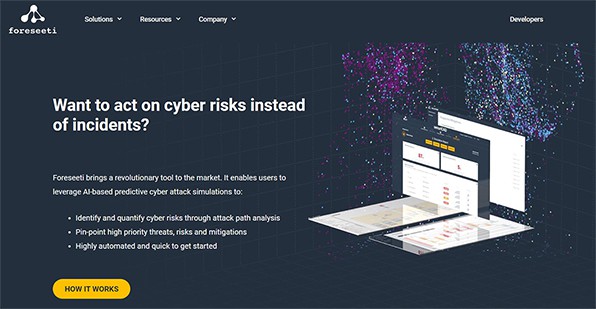
This tool uses attack path analysis to quantify and identify cyber threats. One of the advantages of Foreseeti is that the software leverages AI-based, simulated cyberattacks to identify high-priority risks, mitigations and threats. The software is also easy to use and has excellent customer support. However, one disadvantage is the high price. Foreseeti runs a monthly subscription model for $479 per month.
Foreseeti’s access control system is role-based and can be controlled only by the customer to ensure that clients have total security over the attack system.
Foreseeti is a Swedish cybersecurity company headquartered in Stockholm. The company was founded in 2014 by Joakim Nydren, Mathias Ekstedt and Robert Lagerstrom.
Firstly, Foreseeti models the company’s architecture, including firewall, routers, servers and whatever else needs testing. Using AI-based attacks, the software then tries to determine if the company’s architecture can be broken into. Finally, the threat simulations estimate the behaviors of possible attacks, including the likelihood of success, timeframe and most likely assault vectors.
4. BreachLock
Companies can request and obtain a thorough penetration test from BreachLock’s cyberattack simulation software. BreachLock uses automated and manual vulnerability discovery methods to execute in-depth penetration testing. Afterward, the company is certified for completing the penetration test and receives online and offline system reports.
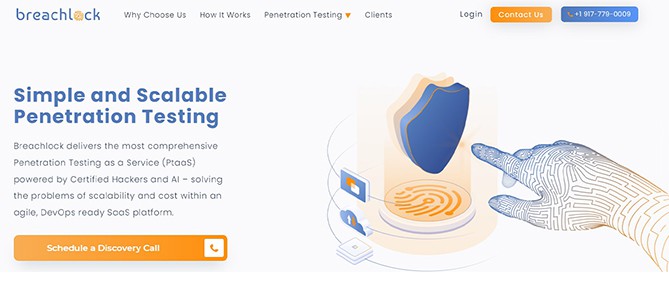
The advantages of BreachLock are numerous, like accurate and quick reporting capabilities, support for various applications, and automatic and manual penetration testing. The major disadvantages, on the other hand, include subpar product support and confusing documentation for developers.
According to BreachLock, companies will need a custom estimate since penetration tests differ for different companies, making a fixed price model challenging to adopt.
BreachLock is a U.S.-based network security firm founded in 2019 by Seemant Sehgal. The headquarters is in New York City, with three other offices spread across the globe.
The company is compliant with the Payment Card Industry Data Security Standard, the Health Insurance Portability and Accountability Act, and SOC2, providing the highest level of security.
Note:
BreachLock works by using advanced AI technology and the power of human hackers to deliver custom-tailored penetration testing as a service to businesses.5. AttackIQ
The AttackIQ security simulation software checks to ensure that a company’s security policies, processes and people perform as expected and achieve results. In addition, AttackIQ integrates seamlessly into any existing network, providing immediate visibility into the security program so users can identify coverage gaps and misconfigurations and prioritize remedial activities.
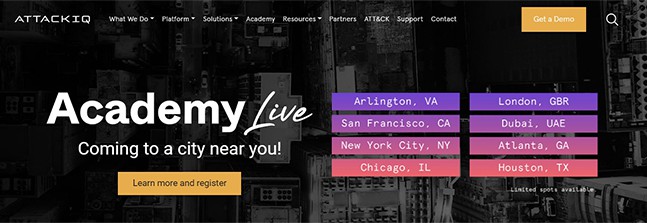
AttackIQ’s main advantage is that the platform houses the most extensive MITRE ATT&CK-aligned library of known harmful behaviors and strategies. One disadvantage, though, is that users need to know cybersecurity tactics and techniques and have some coding knowledge. The setup process is also a bit complex.
AttackIQ has the latest security compliance, including the National Institute of Standards and Technology’s SP 800-53 framework and the Cybersecurity Maturity Model from the U.S. Department of Defense. AttackIQ uses the MITRA ATT&CK, a guideline that describes and classifies cyberattacks, to validate the simulator’s security framework.
AttackIQ costs $5,000 per test point engine, but a demo is also available so companies can test the platform for a short period. AttackIQ is a U.S.-based firm founded in 2013 by Rajesh Sharma and Stephan Chenette in San Francisco, California.
AttackIQ provides customers with consistent, trusted and safe measures to test and validate security controls at scale and in production. AttackIQ runs tests in real-world environments, spanning the whole kill chain.
6. Infection Monkey
Infection Monkey is a free, open-source tool developed by Guardicore that allows users to test the resiliency of data centers to internal server infections and perimeter breachers. IT teams worldwide utilize Infection Monkey to verify network adherence to the zero trust paradigm and uncover flaws in cloud-based and on-premises data centers.
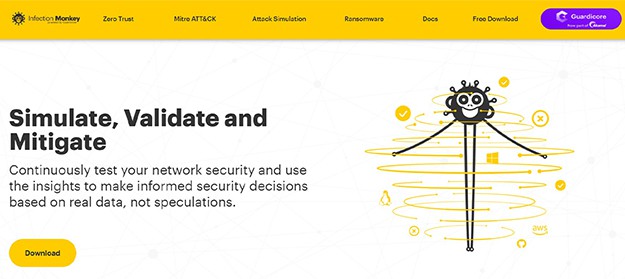
A major advantage is that infection monkey is highly configurable, allowing users to turn any part of the tool into a fast-acting worm to simulate ransomware attacks or a quick response port scanning machine to collect system information. Customer service is one disadvantage of Infection Monkey. Due to how small Guardicore is, the customer service agents are few.
Infection Monkey is an open-source cyberattack simulation tool available for free. Guardicore also runs a public Slack community where users can share ideas and get any help needed. Akamai Technologies, a U.S. cybersecurity firm, acquired Guardicore in 2021 for $600 million.
Infection Monkey works by running a simulated ransomware attack on a network using a predetermined and configurable behavior pattern.
7. CALDERA
CALDERA is another open-source network attack simulation tool used to assist manual red teams and automate adversary emulation and incident response.
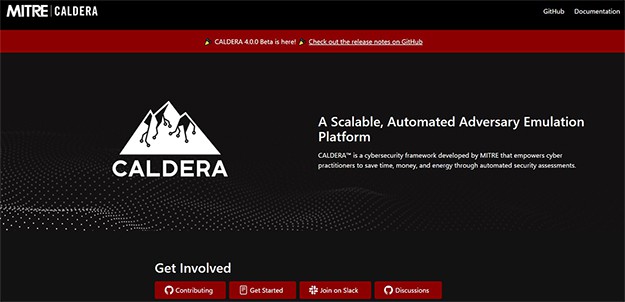
The advantages of CALDERA are that the software helps to reduce the resources companies need for assessments. Organizations can also fine-tune intrusion systems in real-time. Finally, CALDERA allows red teams to develop better solutions to complex problems. However, slow response from customer support is a major disadvantage of CALDERA.
CALDERA was developed by The MITRE Corporation, a not-for-profit that manages a few federally funded research and development centers and works with several U.S. government agencies spanning cybersecurity, health care, homeland security, defense and aviation. The software is completely free.
CALDERA is used to run either defense (blue team) or offensive (red team) operations. Red team operations involve utilizing the framework to deploy custom-made threat profiles to identify gaps in the network. Apart from testing defenses, this also teaches blue teams to detect threats more efficiently.
8. Picus
The Picus platform safely simulates real-world cybersecurity threats, allowing users to continuously assess, measure and improve security protocols. In addition, Picus verifies controls at the detection and prevention layers, such as SIEM, EDR and NGFW tools.
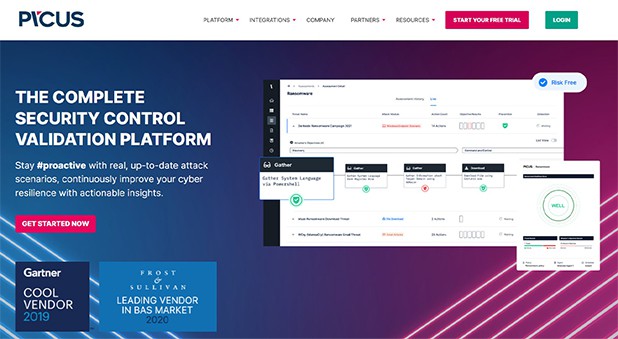
The advantage of Picus is that users can execute specific rules in the network environment. However, one major disadvantage is in the report: Although the software reports when an attack bypasses the security controls, information on the where or which device isn’t available.
Picus has a solid information security policy that helps manage integrity, confidentiality and available information. Picus applies risk and asset management processes to assure relevant parties that the risks are appropriately handled.
The software costs $25,000 per vector assessment, making Picus one of the more expensive simulation tools. Picus is a Turkish cybersecurity firm that was founded in 2013. The company is headquartered in San Francisco, California.
Using evolving threat samples from real-world environments, the Picus platform consistently tests a network’s security capabilities, looking for gaps and seeing how effective the defense is.
9. NeSSi2
NeSSi2 is a network simulation tool loaded with features that distinguish the software from all-purpose network simulation tools. NeSSi2 enables users to simulate various security scenarios and develop the best defense and approach to tackling said scenarios.
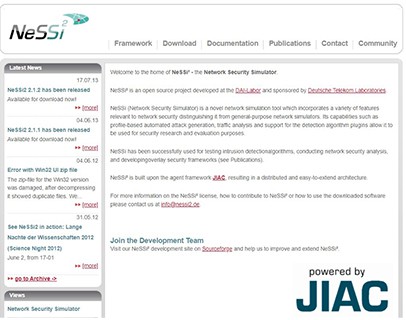
The advantages of NeSSi2 are the detection unit API and attack model with profile and network creation. However, the simulator has not been updated since July 2013, which is a significant disadvantage.
Deutsche Telekom Labs currently holds NeSSi2. The company’s website includes documentation on how to use the software.
NeSSi2 focuses on network analysis, testing intrusion detection algorithms and automatically generated profile-based attacks.
10. XM Cyber
XM Cyber is a hybrid cloud security management software that brings a new method for finding and remediating critical attack pathways by utilizing the attacker’s perspective to get a concise view of multi-cloud and on-premises networks.
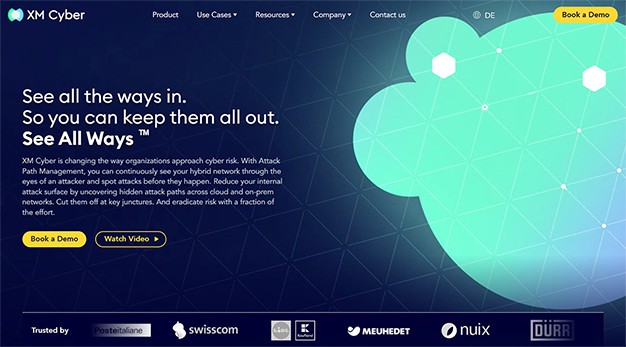
The simulator makes penetration testing more reliable and accessible, which is a major advantage. XM Cyber also provides fixes for the vulnerabilities and gaps discovered so hackers can no longer use those pathways.
XM Cyber has system and organization controls (SOC 2) Type II compliance, ensuring adequate measures have been taken to protect any sensitive data the software comes across.
The software has two main features with different price points for up to 1,000 assets: The hybrid attack simulation feature costs $7,500 per month, and the vulnerability management tool costs $1,083 per month. The cost may vary for different companies depending on the number of assets.
XM Cyber is an Israeli company founded in 2016 by Tamir Padro, a former director of Mossad. Schwarz Group has since acquired XM Cyber for $700 million in 2021.
XM Cyber works by using the attack path management feature to observe the network through an attacker’s point of view, which trains users to spot attacks early and defend or carry out preventive actions.
How Cyber Attack Simulation Tools Test Security
Cyberattack simulation tools or network attack tools test security by mimicking malicious agents’ techniques and attack pathways using various testing methods.

A penetration test (also known as “pentest” or “pen-test”) looks for and exploits security flaws in a firm’s networks and services. Experts use real-world attack tactics on the targeted system to achieve a predetermined goal during a pentest. Penetration testing is used to check and locate vulnerabilities before potential hackers gain access through said gaps. Businesses can also replicate the whole assault process against networks in real-time using BAS (Breach and Attack Simulation) software, virtual computers and other methods. BAS automates and executes testing continuously.
Note:
Although BAS tools do not have the ingenuity and originality as white hats or malicious agents, most can run tests constantly over a wide range of attack types. Vulnerability testing, which is not a simulation but a scan done on a network system, can also be carried out to check for known vulnerabilities. The system gathers information from the network and associated devices and compares the results to a vulnerability database.What Attacks can a Cyber Attack Simulation Tool Make?

Most cyberattack simulation tools carry out breach and attack simulation, while a few, such as BreachLock, do penetration testing.
Breach and attack simulations often start with a phishing attack. Next, the attacking team tries to get the victim to download and install malware. Then the attackers focus on openings and internal threats that can be used to gain access and steal data and credentials.
There are different types of penetration testing, each carried out per the company’s objectives. In external testing, the attackers try to penetrate the company’s network from outside the system. Internal testing is done from within the organization. In all stages, the attackers use web applications such as backdoors, SQL injections and cross-site scripting to locate vulnerabilities in the network. The attackers then try to use these vulnerabilities to intercept traffic and steal data to understand the damage real malicious actors can cause.
What are the Features of Cyber Attack Simulation Tools?
The features of cyberattack tools are modeling, risk reporting and vulnerability scanning.

Cyberattack simulation tools use modeling to visualize the path of attack. Once the model is created, the tool simulates an attack on the model of the system. Users can add and remove assets that require testing depending on the simulator.
The risk report feature then generates a report of the attack so users can identify weaknesses and bolster defenses. Finally, the vulnerability scanner scans the network for vulnerabilities and compares the result to a database of publicly reported vulnerabilities. The organization can then take measures to fix any vulnerability found.

